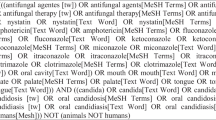Abstract
Twenty-five patients seen consecutively at an HIV outpatient clinic who had clinical evidence of oropharyngeal candidiasis and two or more oral swabs positive for yeasts on culture were studied retrospectively. For each of the 65 isolates susceptibility to fluconazole was evaluated by the disk diffusion test and determination of the minimal inhibitory concentration (MIC). A correlation was sought between clinical resistance and in vitro susceptibility data. Seven patients were non-responders and 19 were responders (one patient figuring in both groups). Significant differences were observed between the two groups with respect to the median interval after the diagnosis of AIDS (27 months in non-responders and 2 months in responders; p=0.001), the median CD4+ cell count (6 and 21 cells/mm3 respectively; p=0.005) and the median number of previous episodes of oropharyngeal candidiasis treated with fluconazole (13 and 2 episodes respectively; p=0.001).Candida albicans was identified in 64 of 65 cultures. The correlation between MIC values and diameters of inhibition was good (r=0.85; p<0.001). The degree of in vitro susceptibility of the isolates to fluconazole showed a significant difference between non-responders and responders (mean inhibition diameters 13 and 36 mm respectively; p<0.001) with a tentative cut-off value of 25 mm. An advanced stage of HIV infection and previous exposure to fluconazole could be risk factors for the development of fluconazole-resistant oropharyngeal candidiasis.Candida albicans strains with decreased in vitro susceptibility to fluconazole were responsible for the clinical resistance which could be predicted by a simple disk diffusion test.
Similar content being viewed by others
References
British Society for Antimicrobial Chemotherapy Working Party Antifungal chemotherapy in patients with acquired immunodeficiency syndrome. Lancet 1992, 340: 648–651.
Brammer KW, Farrow PR, Faulkner JK Pharmacokinetics and tissue penetration of fluconazole in humans. Reviews of Infectious Diseases 1990, 12, Supplement 3: 318–326.
De Wit S, Weerts D, Goossens H, Clumeck N Comparison of fluconazole and ketoconazole for oropharyngeal candidiasis in AIDS. Lancet 1989, i: 746–747.
Thorsen S, Mathiesen LR Fluconazole for ketoconazole-resistant oropharyngeal candidiasis in HIV-1 infected patients. Scandinavian Journal of Infectious Diseases 1990, 22: 375–376.
Chave JP, Cajot A, Bille J, Glauser MP Single-dose therapy for oral candidiasis with fluconazole in HIV-infected adults: a pilot study. Journal of Infectious Diseases 1989, 159: 806–807.
Wingard JR, Merz WG, Rinaldi MG, Johnson TR, Karp JE, Saral R Increase inCandida krusei infection among patients with bone marrow transplantation and neutropenia treated prophylactically with fluconazole. New England Journal of Medicine 1991, 325: 1274–1277.
Fox R, Neal KR, Leen CLS, Ellis ME, Mandal BK Fluconazole resistantCandida in AIDS. Journal of Infection 1991, 22: 201–203.
Kitchen VS, Savage M, Harris JRW Candida albicans resistance in AIDS. Journal of Infection 1991, 22: 204–205.
Smith D, Boag F, Midgley J, Gazzard B Fluconazole resistantCandida in AIDS. Journal of Infection 1991, 23: 345–346.
British Society for Antimicrobial Chemotherapy Working Party Laboratory monitoring of antifungal chemotherapy. Lancet 1991, 337: 1577–1580.
Shadomy S, Pfaller MA Laboratory studies with antifungal agents: susceptibility tests and quantitation in body fluids. In: Balows A, Hausler WJ, Herrmann KL, Isenberg HD, Shadomy HJ (ed): Manual of clinical microbiology. American Society for Microbiology, Washington, DC, 1991, p. 1173–1183.
Pfaller MA, Rinaldi MG, Galgiani JN, Bartlett MS, Body BA, Espinel-Ingroff A, Fromtling RA, Hall GS, Hughes CE, Odds FC, Sugar AM Collaborative investigation of variables in susceptibility testing of yeasts. Antimicrobial Agents and Chemotherapy 1990, 34: 1648–1654.
Powderly WG, Robinson K, Keath EJ Molecular typing ofCandida albicans isolated from oral lesions of HIV-infected individuals. AIDS 1992, 6: 81–84.
Miyasaki SH, Hicks JB, Greenspan D, Polacheck I, MacPhail LA, White TC, Agabian N, Greenspan GS The identification and tracking ofCandida albicans isolates from oral lesions in HIV-seropositive individuals. Journal of Acquired Immune Deficiency Syndrome 1992, 5: 1039–1046.
Pfaller MA, Dupont B, Kobayashi GS, Müller J, Rinaldi MG, Espinel-Ingroff A, Shadomy S, Troke PF, Walsh TJ, Warnock DW Standardized susceptibility testing of fluconazole: an international collaborative study. Antimicrobial Agents and Chemotherapy 1992, 36: 1805–1809.
Author information
Authors and Affiliations
Rights and permissions
About this article
Cite this article
Troillet, N., Durussel, C., Bille, J. et al. Correlation between in vitro susceptibility ofCandida albicans and fluconazole-resistant oropharyngeal candidiasis in HIV-infected patients. Eur. J. Clin. Microbiol. Infect. Dis. 12, 911–915 (1993). https://doi.org/10.1007/BF01992164
Issue Date:
DOI: https://doi.org/10.1007/BF01992164



